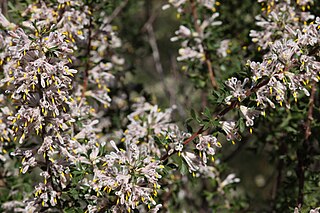
Petrophile linearis, commonly known as pixie mops, is a species of flowering plant in the family Proteaceae and is endemic to southwestern Western Australia. It is a shrub with narrow egg-shaped leaves, the narrower end towards the base, and oval to spherical heads of hairy, greyish-pink or mauve to almost white flowers.

Petrophile biloba, commonly known as granite petrophile, is a species of flowering plant in the family Proteaceae and is endemic to the south-west of Western Australia. It is a shrub with pinnately-divided leaves with sharply-pointed tips, and oval heads of hairy, mostly grey to pink flowers.

Petrophile canescens, commonly known as conesticks, is a species of flowering plant in the family Proteaceae and is endemic to eastern Australia. It is an erect shrub with pinnately-divided leaves and oval heads of hairy, white to pale cream-coloured flowers.

Petrophile acicularis is a species of flowering plant in the family Proteaceae and is endemic to southwestern Western Australia. It is a low, tufted shrub with cylindrical leaves and oval heads of densely hairy, cream-coloured flowers.

Petrophile antecedens is a species of flowering plant in the family Proteaceae and is endemic to the south-west of Western Australia. It is a small, erect, open shrub with sharply-pointed, cylindrical leaves and spherical heads of hairy, pale cream-coloured flowers.

Petrophile arcuata is a species of flowering plant in the family Proteaceae and is endemic to the south-west of Western Australia. It is a spreading shrub with cylindrical leaves and oval to spherical heads of hairy yellowish flowers.

Petrophile brevifolia is a species of flowering plant in the family Proteaceae and is endemic to the south-west of Western Australia. It is a shrub with cylindrical, sharply-pointed leaves, and spherical heads of hairy yellow, cream-coloured or white flowers.
Petrophile crispata is a species of flowering plant in the family Proteaceae and is endemic to southwestern Western Australia. It is a shrub with pinnately-divided leaves with sharply-pointed tips, and oval heads of glabrous, yellow flowers.

Petrophile divaricata is a species of flowering plant in the family Proteaceae and is endemic to southwestern Western Australia. It is a shrub with bipinnate, sharply-pointed leaves, and oval to oblong heads of hairy, yellow flowers.

Petrophile diversifolia is a species of flowering plant in the family Proteaceae and is endemic to southwestern Western Australia. It is a shrub with pinnate, sharply-pointed leaves, and oval heads of densely hairy, white or creamy-white flowers.

Petrophile helicophylla is a species of flowering plant in the family Proteaceae and is endemic to southwestern Western Australia. It is a prostrate, spreading shrub with twisted, needle-like leaves and heads of hairy white to creamy-white or pale pink flowers.
Petrophile incurvata is a species of flowering plant in the family Proteaceae and is endemic to southwestern Western Australia. It is a shrub with flattened, sometimes pinnately-divided leaves with up to five sharply pointed lobes, and cylindrical to oval heads of silky-hairy, cream-coloured to yellowish-white flowers.

Petrophile megalostegia is a species of flowering plant in the family Proteaceae and is endemic to southwestern Western Australia. It is a shrub with needle-shaped or flattened, sometimes S-shaped leaves with a sharply-pointed tip, and more or less cylindrical heads of silky-hairy, yellow to cream-coloured flowers.

Petrophile plumosa is a species of flowering plant in the family Proteaceae and is endemic to southwestern Western Australia. It is a shrub with rigid, sharply-pointed, sometimes lobed leaves, and more or less spherical heads of hairy, pale yellow flowers.
Petrophile stricta is a species of flowering plant in the family Proteaceae and is endemic to the south-west of Western Australia. It is an erect, spreading shrub with needle-shaped, sharply-pointed leaves, and oval heads of hairy, pink to cream-coloured flowers.

Petrophile teretifolia is a species of flowering plant in the family Proteaceae and is endemic to the south-west of Western Australia. It is a shrub with needle-shaped but blunt-pointed leaves, and oval to more or less spherical heads of hairy pink to mauve flowers.

Isopogon inconspicuus is a plant in the family Proteaceae and is endemic to the southwest of Western Australia. It is a small shrub with pinnate leaves with cylindrical leaflets, and pink to purple flowers covered with grey hairs.
Isopogon robustus, commonly known as robust coneflower, is a plant in the family Proteaceae and is endemic to a restricted area in the southwest of Western Australia. It is a shrub with cylindrical leaves and oval heads of pink flowers.
Petrophile foremanii is a species of flowering plant in the family Proteaceae and is endemic to southwestern Western Australia. It is a shrub with more or less cylindrical leaves and elliptic to spherical heads of hairy, creamy yellow flowers on the ends of branchlets.
Petrophile globifera is a species of flowering plant in the family Proteaceae and is endemic to southwestern Western Australia. It is a shrub with more or less cylindrical leaves and elliptic to spherical heads of cream-coloured to pale yellow flowers on the ends of branchlets.
















